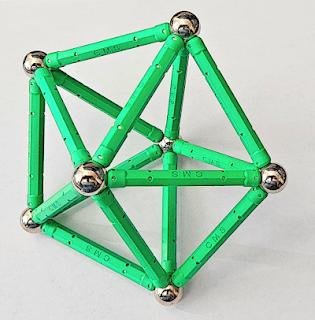Rigid Frameworks
My colleague Gabriella Pinter presented a neat 2D rigidity activity at JMM this January that I might write about later, but it reminded me of a 3D rigidity exploration that I've enjoyed running over the years.
Setup
For this activity, you'll need to put together a kit of struts and joints. My photos will come from a kit made up of metal ball bearings and magnetic rods. Here are a couple of those options:A simple budget option is toothpicks with marshmallows or gumdrops. If you want a larger group-building experience, Ogo Bild Pod is a great option. It seems they might have halted producing these kits, but you might be able to find a reseller. Students are to play with the kit and explore the idea of rigidity. What it means for a structure to be rigid is that, relative to the other components, each component is fixed. This means the only notion possible for the structure is translation and rotation in space, but no struts can hinge relative to any others without breaking connections. Because students will always be building skeletal frames with this kit, we'll call these objects frameworks or simply structures. If the words joints and struts feel goofy, feel free to say "balls and sticks," "marshmallows and toothpicks," or other names reflecting your building materials.
Example: Triangle
A triangle is a rigid structure, since trying to move any strut without moving another must disconnect a strut from a joint.
Example: Cube
A cube is not a rigid structure, because the entire frame can be distorted away from the cubic shape into a parallelepiped or other shapes:

|

|
Example: Tetrahedron
The tetrahedron is rigid.
Example: Square Pyramid
The square pyramid is not rigid. Although on a table top it might seem rigid, the table actually reinforces the base square, which is flexible if the pyramid is placed on its side:

|

|
Initial Questions
- Are there any structures you expect to be rigid or nonrigid?
- What is it that rigid structures have in common that nonrigid structures lack?
- If a structure is nonrigid, what are some ways you could fix it so it becomes rigid?
Explorations
The main exploration line I use with this activity is as follows: Give each student a set number of joints and have them investigate the rigid structures they can make using that number of joints. A good starting point is 5 joints if you've used 4 joints as an example.- Is it possible to create a rigid structure with 5 joints?
- Is every rigid structure with 5 joints the same or are there different looking structures that can be built?
- How many struts does each rigid structure you've built require?

|

|

|

|

|

|

|
| Joints | Struts |
|---|---|
| \(3\) | \(3\) |
| \(4\) | \(6\) |
| \(5\) | \(9\) |
| \(6\) | \(12\) |
| \(7\) | \(15\) |
If they are familiar with linear relations, students might be able to write down \[ e = 3v - 6 \] where we follow the graph theory convention of using \(v\) (vertices) for joints and \(e\) (edges) for struts. Otherwise, they can probably describe the relationship in terms of counting by threes. This is actually only part of the story, since if we had struts of different sizes we could build rigid structures with \[ e > 3v - 6 \] by doing things like bracing already rigid structures with extra struts, so the fuller story is \[ e \geq 3v - 6 \]
Students likely won't encounter strict inequality unless playing with a large number of struts, however.
Wrap-Up Questions
- Was there a good way to guess whether a structure would be rigid just by looking at it?
- Were you surprised that any structures turned out to be rigid or nonrigid?
- How many struts do you think you would need to build a rigid structure with 10 joints? 100 joints?
Extensions
- Can students find a rigid structure with \(e\) struts and \(v\) joints so that \[ e \neq 3v - 6 \] and how large does \(v\) have to be before this is possible?
- Students will likely notice that the structures they are building feature a lot of triangles. Is it possible to create a rigid structure where one of the struts is not part of a triangle? Or are there ways to achieve rigidity without "as many" triangles?
- How does this activity change if not all struts are the same length?
- For students with a more formal algebraic background, they can explore manipulating equations. Most of the objects they create will involve \[ e = 3v - 6 \] Many will also be based on simple polyhedra. As long as the polygon it is based on does not have any holes (think like the hole in a doughnut), then the number of edges and vertices are also related to the number of faces by Euler's Formula: \[ v - e + f = 2. \] We can then explore the system \[ \begin{cases} e = 3v - 6 \\ v - e + f = 2 \end{cases} \] If we multiply the bottom equation by 3 and rearrange it, we get \[ 3e - 3f = 3v - 6 \] and substituting in the first equation to eliminate v gets us \[ 3e - 3f = e \] or \[ 3f = 2e. \] We also know that every edge is shared by exactly two faces. If \(a\) is the average number of edges per face, then we have \[ af = 2e \] and we've just seen that \(a = 3\). Since the number of edges on any given face is always 3 or greater, it must be the case that every face is a triangle!






Comments
Post a Comment